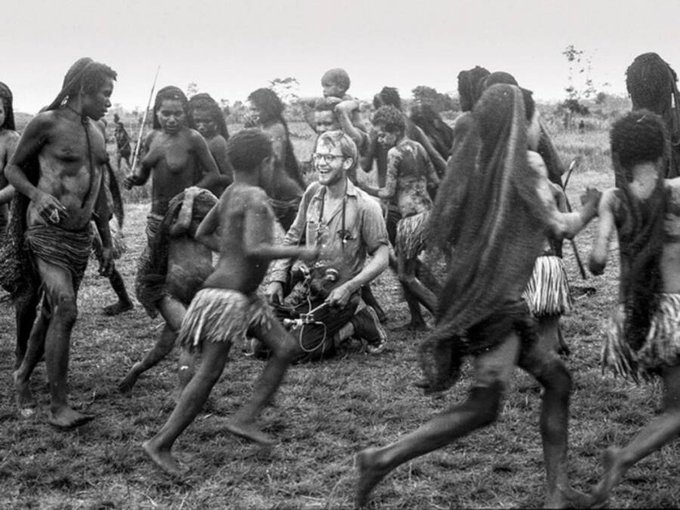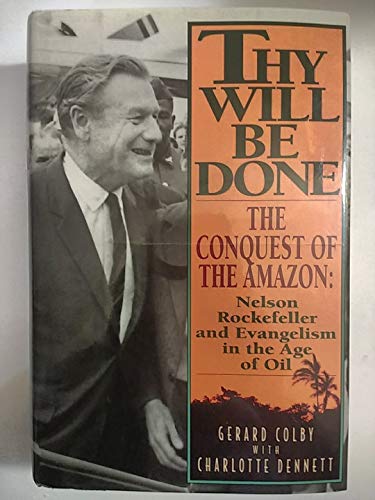
Pictured above is a smiling young Michael Rockefeller, son of the powerful Senator, Vice President and all-around rich dude Nelson Rockefeller. This is said to be one of the last photo’s of Michael before he fell victim to a revenge killing by cannibals in southwest New Guinea. He looks so happy.
This article is the result of the internet sleuthing of various characters, an excerpt of a book about Rockefeller published in “The Smithsonian” magazine, and the immense book “Thy Will Be Done”, a history of the Rockefellers and how they raided the planet. Sources are included at end of this article.
According to Colby and Dennett in “Thy Will Be Done”, “Michael rebelled at the thought of entering the family business”. The young Rockefeller, like his father Nelson, was driven to visit exotic places to provide tribal art for Dad’s Museum of Primitive Art. Indeed, Michael fearlessly immersed himself in far-off jungles and potentially dangerous situations.
Nelson Rockefeller may have had other motives for collecting tribal artifacts from regions such as what was then called “Dutch New Guinea” (soon to be Indonesia). Standard Oil, a Rockefeller empire, had been drilling for oil in the area since 1914, and another huge corporation, Freeport Sulphur, had discovered a remote mountain that was almost entirely composed of copper. They wanted that fortune, and the Dutch were more than happy to help.
As Colby and Dennett write; “..the Dutch needed more prestigious American social scientists in New Guinea. To both Freeport Sulphur and the Dutch, that meant social scientists from Harvard”.
In this way, Harvard trained Michael Rockefeller was introduced to Dutch New Guinea.
In his 2014 book “Savage Harvest: A Tale of Cannibals, Colonialism, and Michael Rockefeller’s Tragic Quest for Primitive Art”, Carl Hoffman describes his journey to find out what happened to Rockefeller. The issue of Smithsonian Magazine linked at the end of this article has a lengthy excerpt written by Hoffman.
In the Smithsonian article Hoffman describes the cover-up of the 50-year-old disappearance conducted by colonial authorities, missionaries, and members of the Asmat tribe. It seemed as though nobody wanted this issue to see the light of day.
He finally got to the bottom of what happened. What follows is compiled from the Smithsonian article and the book “Thy Will Be Done”.
The Asmat and other tribes had been isolated for an eternity, but beginning in the 1950’s missionaries began venturing into their remote jungles. Despite the ritual combat and head-hunting practiced by the tribes, no westerners had ever been killed by them. That is, until Michael Rockefeller.
The trouble started years earlier in 1958, when nearly 100 members of several tribes were killed in mutual combat. That was too big a toll for Dutch authorities, who sent a militarized police unit in to punish the Asmat tribe, whose land was near the rich copper find. In the fight that ensued, they killed a number of tribesmen with rifle fire. The natives had never experienced such mysterious ways of killing, and they held a grudge.
In 1961 Michael Rockefeller collected everything he could get his hands on, using steel axes, fishing hooks, cloth and tobacco as trading goods. He was able to gather drums, bamboo horns, spears, paddles and shields. The Asmat and other tribes were prolific woodcarvers.
However, Colby and Dennett describe “There was a dark side to Michael’s work… He collected beautifully painted human skulls. ..The Dutch authorities were aghast. They tried to warn him off because “He was creating a demand that could not be met without bloodshed”.
In the fall of 1961 Rockefeller convinced a local policeman to sell him a homemade catamaran, which he used in an attempt to reach the Asmat tribe. Entering a strong river current from a raging sea, the outboard motor died and the boat was swamped. Two local men survived the swim ashore, while Rockefeller and another man clung to the swamped boat, drifting further to sea.
Nelson Rockefeller was alerted back in the states, and a huge land, sea and air rescue mission had begun.
In the dim morning light, with the swamped boat drifting further to sea, Michael strapped several floating canisters to his waist and began the swim to shore. He had stripped down to his underwear to swim better, while his companion clung to the boat and was later rescued.
Michael survived the grueling swim, and was confronted by members of the Asmat tribe as he reached the shore.
In his book and Smithsonian article on Rockefeller, Carl Hoffman writes about the lengthy process of making the tribe comfortable enough to discuss the events of that day. For obvious reasons, they were scared to reveal what had actually occurred, but in sometimes off-handed, rambling stories, he learned that they had talked about the strange short pants Rockefeller had worn (his underwear), and Hoffman knew this was the correct event.
In this excerpt, Colby and Dennett borrow from another book on Michael Rockefeller:
“Later, when Michael finally emerged from the sea after his long swim, he found not rescue, but death from Ajam’s party. He was speared just below his left collarbone as he came ashore. He was still alive when taken upriver, killed with an axe, and, in the religious manner of cannibals seeking the strength of their victims, cooked with sago palm and eaten”.
Nelson Rockefeller never raised an issue with the Dutch authorities about how badly they managed Michael Rockefeller’s jungle excursions. There was plenty of fault to go around, between the Dutch officials, the Catholic missionaries, the escort (an ethnographer) and the huge corporations, all wishing to keep a lid on the killing.
The Indonesian island chain yielded great wealth. There were vast oilfields, mineral riches, and rubber plantations.
As Colby and Dennett write:
“The economic stakes were too high for Nelson to risk a personal vendetta against Dutch officials for Michael’s death”.
Later, in 1965, the CIA overthrew the government of Indonesia, making the region “safe for transnational investment”.
Photo and editorial credit for Smithsonian here:
https://www.smithsonianmag.com/history/What-Really-Happened-to-Michael-Rockefeller-180949813/
And “Thy Will Be Done”, by Colby and Dennett:

-John Titus


Nothing like having to pay for the sins of the father!
Revenge… sweet and tasty! I had no idea about this… thanks for the REAL news…